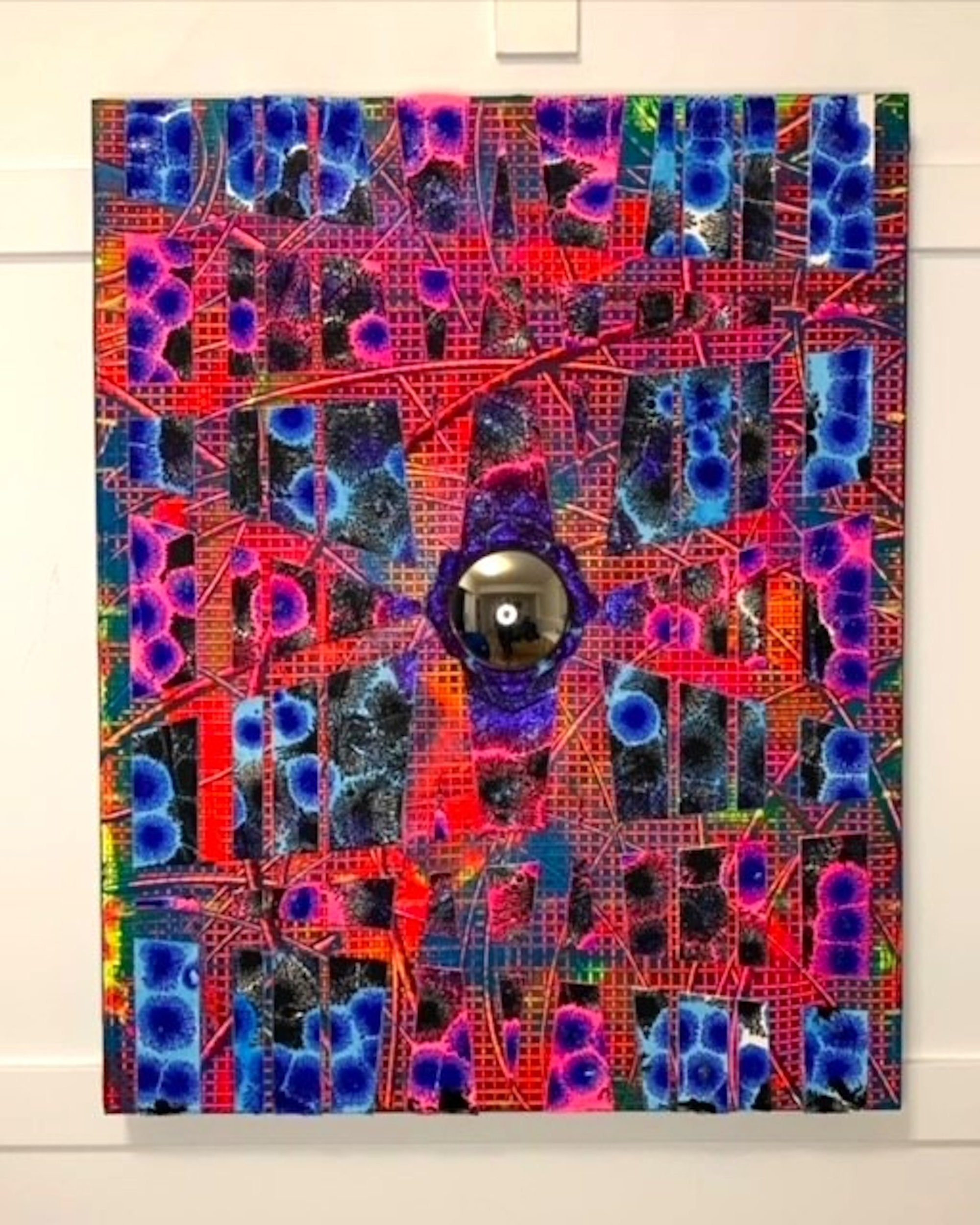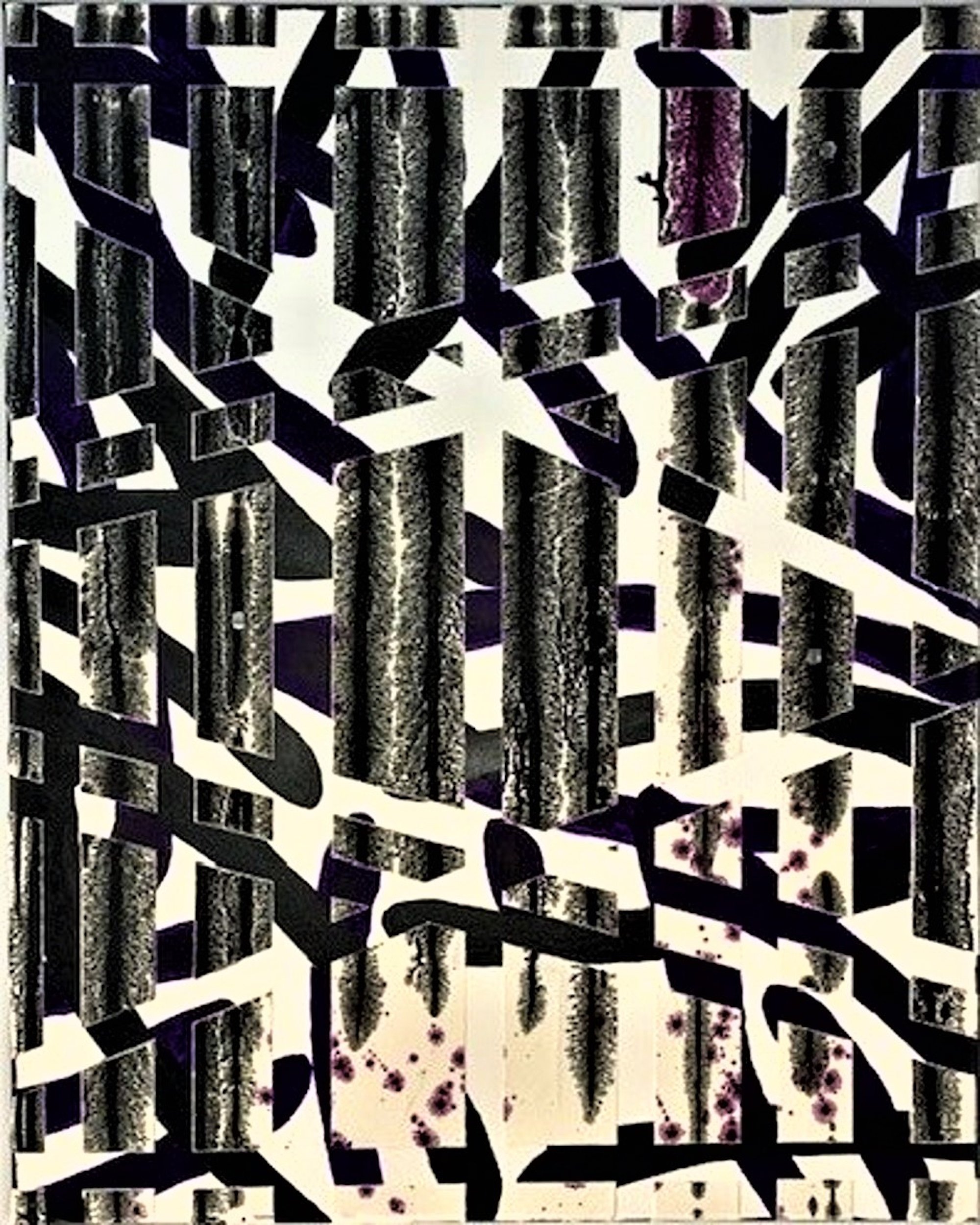Lincoln Howard
Lincoln Howard
https://www.instagram.com/lincolnhowardart/
Lincoln Howard's mixed media artworks are a vibrant testament to the power of self-taught mastery and intuitive creativity.
At first glance, the bold, grid-like patterns that dominate Howard's canvases might remind viewers of the labyrinthine urban landscapes, or perhaps of the inner workings of a complex machine. This motif, which Howard employs across many of his pieces, is more than a mere stylistic choice; it symbolizes the intricate matrix of life, a theme deeply embedded in his work. The grids speak to the interconnectedness of human experience, the network of choices and paths that each individual navigates, creating a rich tapestry of personal and collective history.
Howard's technique of incorporating a special paste to create depth and texture further differentiates his work from his contemporaries. This not only adds a sculptural quality to the paintings, inviting the viewer to experience the work through multiple senses, but it also enhances the metaphorical depth of his art. The textured surfaces evoke the tangible realities of life's experiences, the scars, and embellishments that time etches upon the world and the self.
When compared to the likes of Francis Bacon, Jackson Pollock, and Jean-Michel Basquiat, Howard's work may draw superficial parallels—Bacon's visceral representations of the human condition, Pollock's energetic action paintings, and Basquiat's raw, graffiti-inspired commentary on culture and society. Yet, Howard's art distinguishes itself in its pursuit of a more profound philosophical introspection. Where the aforementioned artists each dissected the human experience with a surgeon's blade, laying bare the often-chaotic essence of existence, Howard opts for a more holistic approach, weaving together the chaotic and the structured to produce a visual symphony that speaks to the soul's search for meaning within the maze.
This depth of philosophical inquiry is evident in the careful balance of order and chaos within Howard's pieces. The use of vibrant colors against the rigid structure of the grid creates a dichotomy that reflects the unpredictability of life against the backdrop of its underlying order. It's a visual metaphor for the age-old philosophical debate on free will versus determinism, individuality versus collectivism, and the natural versus the constructed.
Howard's artworks hold significant importance for the art world because they challenge viewers to engage in self-reflection. They are not passive images to be glanced at; they are conversations to be had. In an era where much of contemporary art is focused on the external—on social commentary, on political statements, on the observable universe—Howard turns the gaze inward, asking us to consider the uncharted territories of our own psyches. This introspective quality is a vital addition to the discourse of modern art, providing a counterbalance to the outwardly focused narratives that dominate much of the contemporary scene.
Howard's art does not alienate; it invites inclusivity. The abstract nature of his work means that it is open to interpretation, allowing viewers from all walks of life to find their own meaning within the canvas. This universality is the hallmark of great art—it transcends boundaries, defies easy categorization, and becomes a mirror in which the diversity of human experience is reflected.
Lincoln Howard's mixed media artworks are a testament to the power of intuitive artistry. His unique style, characterized by a fusion of grid patterns and textured surfaces, offers a rich visual experience that speaks to both the mind and the senses. Through his work, Howard not only continues the conversation started by the likes of Bacon, Pollock, and Basquiat but also elevates it, infusing his art with a depth of philosophical inquiry that challenges and inspires. As the art world continues to evolve, Howard's contributions stand out as a beacon of introspection and contemplation, inviting us to ponder the complex matrix of life and our place within it.
The "matrix of life" is a concept deeply embedded in Lincoln Howard's artwork, acting as both a visual motif and a philosophical underpinning. This matrix is often represented by the grid patterns that are a hallmark of his style, evoking a sense of structure amidst the chaos of existence. The grid serves multiple symbolic functions: it is a metaphor for the societal, cultural, and personal constructs within which we operate; it represents the frameworks of understanding we impose on the world to make sense of it; and it reflects the interconnected nature of our lives, where each decision affects not only our own trajectory but also the lives of others.
In Howard's work, this matrix is not static but vibrantly alive, pulsating with color and texture. The overlay of bright, often unexpected hues on the grid lines suggests the unpredictable nature of life's events and emotions that course through our structured existence. It captures the essence of life as a dynamic interplay between order and chaos, planning and spontaneity, predictability and surprise. Each piece becomes a microcosm of the human experience, where the planned and the unplanned, the rational and the emotional, the mundane and the extraordinary coexist.
Howard's use of texture adds another dimension to the matrix of life. The raised surfaces and the tactile nature of the paintings remind us that life is not a two-dimensional journey. Instead, it is layered and complex, filled with moments that stand out in relief against the smooth continuum of time. These textural elements invite the viewer to consider the depth of their experiences, the highs and lows that define individual narratives.
In reflecting on the matrix of life, one cannot help but think of the way in which our lives are woven together, much like the intersecting lines on Howard's canvases. Every point where lines intersect represents a moment of choice, a meeting with another person, an event that changes the course of our path. The grid is the pattern of society itself—the routines we follow, the rules we adhere to, and the cultural norms we navigate.
Yet, within this framework, Howard's use of vivid colors and textures also speaks to individual agency—the human capacity to bring beauty, change, and personal expression into the rigid structures that govern our lives. The splashes of paint that cross the grid lines act as symbols of personal rebellion, creativity, and the inherent human desire to leave a mark on the world, to color outside the lines.
Howard's artworks thus become a canvas for philosophical meditation on the nature of existence. They challenge the viewer to consider their place within the vast network of life, to recognize the beauty of the grid as well as the significance of breaking from it. His paintings are an invitation to explore the balance between the life we are given and the life we create for ourselves, and in doing so, they provide a visual framework for understanding the complex, beautiful, and sometimes contradictory nature of human existence.
In the greater conversation of art and life, Howard's matrix is a powerful symbol of the search for meaning within the structures that define our world. His work is a reminder that while life may be framed by a matrix of societal and personal constructs, there is always room for individual interpretation, improvisation, and the injection of vibrant, life-affirming color.
Lincoln Howard's artistic message, conveyed through the matrix of life, is significant for several reasons.
Howard's work invites introspection about our place within the complex systems that define our lives. His grids and textures serve as metaphors for the various aspects of human existence—social structures, personal choices, and the interplay between the individual and the collective. In a world that can often seem overwhelming or impersonal, Howard's art encourages viewers to reflect on their paths and the impact of their decisions.
By juxtaposing the orderly grid with chaotic bursts of color and texture, Howard's art captures the essence of the human condition, which is a continuous negotiation between the predictable and the unpredictable. This message is particularly relevant in the modern age, where the pace of change and the volume of information can lead to a sense of disorder. Howard's art reassures that within this chaos, there is a pattern and a purpose.
Despite the constraints that life's matrix imposes, Howard's art champions the idea that personal expression and creativity can flourish. In a society often dominated by conformity, his message underscores the importance of individuality and the unique contributions that each person can make to the tapestry of life.
The depth and interactivity of Howard's textured surfaces encourage viewers not just to observe but to engage with the artwork. This mirrors the active role that individuals must take in their lives—engaging with the world around them, questioning norms, and shaping their destiny.
In today's globalized world, the interconnectedness of humanity is more apparent than ever. Howard's grids symbolize how our lives are woven together, reminding us of our collective responsibility and the impact of our actions on others. Howard's abstract approach transcends language and cultural barriers, allowing for a universal message that can be understood and appreciated by diverse audiences. This aspect of his work is essential in a world that is increasingly connected yet divided by language and cultural differences. Howard's status as a self-taught artist serves as an inspiration for others. It emphasizes the value of perseverance, self-education, and the pursuit of one's passions outside of formal institutional frameworks. In an era where art is often commercialized and created for mass consumption, Howard's work insists on maintaining a level of philosophical depth. This depth challenges the viewer to think deeply about the artwork and its implications, rather than passively consuming it.
The process of engaging with Howard's art can have a meditative and therapeutic effect. The patterns and colors, along with the tactile nature of his work, can serve as a form of visual therapy, helping viewers to find calm and contemplation.
In the art world and beyond, Howard's message carries weight because it resonates with core aspects of human life. His work is not just to be seen; it is to be experienced and pondered over, serving as a catalyst for thought about the nature of existence, the beauty of life's complexities, and the power of human creativity.
Lincoln Howard's contribution to the art scene is significant and multifaceted. His distinctive approach, characterized by the symbolic matrix of life, vibrant color use, and rich textural depth, situates him as a poignant commentator on the human condition. His works are not merely to be observed; they are to be experienced, serving as interactive vessels for philosophical reflection, emotional resonance, and personal introspection.
Howard's place in the art scene is that of an innovator and a bridge between the intuitive impulses of self-taught artists and the intellectual rigor of philosophical art. His ability to blend these realms with a unique visual language has carved out a niche that is both accessible to a broad audience and deeply respected among art connoisseurs. His work speaks to the contemporary moment while offering a timeless meditation on life's complexities, ensuring its relevance across generations.
Howard's art stands as a testament to the enduring power of self-expression and the importance of personal vision. In a world where the art market can often seem saturated with works that prioritize shock value or fleeting trends over substance, Howard's dedication to depth and meaning sets him apart. His pieces offer a counterpoint to the ephemeral, anchoring the viewer in a moment of contemplation about the structures that shape our lives and the vibrant human spirit that animates them.
As the art world continues to evolve, Lincoln Howard's work is poised to remain important, serving as a reminder of the transformative power of art. His pieces are not just painted canvases; they are mirrors held up to the soul of society, reflecting the beauty, chaos, and profound interconnectedness of our shared journey. In this way, Howard’s work is both a celebration of individual agency and a recognition of collective experience, positioning him as a vital voice in the art world—one whose works are likely to resonate and inspire for years to come.












